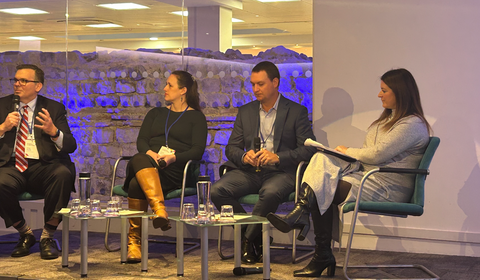We asked our leaders to tell us what they expect to see in the insurance industry in 2025. From wearable biotech to GenAI advancements and avoiding Medicare compliance penalties, there are a lot of changes coming to the industry. These insights help us prepare for the remainder of the year and early 2026.
Wearables in the workplace
Nesha Courtney, Manager - Advocacy, Biopsychosocial, Disability, and Return to Work Services, Broadspire
"In 2025, we expect wearables, including smart helmets, sensors, and monitors, to play an increasingly influential role in workplace safety. This shift is driven by two key factors: firstly, employers are more actively recognizing the full impact of workplace injuries. They're seeing statistics such as the U.S. Government Accountability Office's 2022 report, which noted 700,000 nonfatal injuries and 2,000 fatal accidents in the warehousing, manufacturing, and construction industries alone. And secondly, employees are becoming more vocal about their desire to stay healthy and safe.
"Employers are acutely aware of the steep up-front costs associated with wearable devices, and until now, this has been a hindrance to adoption. However, they are increasingly willing to make the investment, recognizing the long-term benefits such as a decrease in injury-related expenses. The data generated from wearables enables companies to take proactive steps, such as positioning workers in ways that minimize injury risks. This strategic approach not only reduces the incidence of injuries but also offers employers a positive way to address workers' increasing demands for safety and well-being."
Cyber supply and demand
Paul Handy, Global Head of Cyber, Crawford & Company
"Despite the availability of low rates, easy access, and broad coverage, a key cyber insurance challenge for 2025 will be aligning supply with demand. The current emphasis on value-added services and embedded tools aimed at risk management may not fully resonate with customer preferences.
"There is a growing argument for the simplification of policy wordings, especially in the SME sector. Customers are likely to favor straightforward coverages and limits that are easy to understand and directly meet their needs. This includes having access to expert response and claims services. Specifically, the complexity of cyber insurance wordings and the associated uncertainties in recovery are seen as barriers that prevent a necessary increase in both value and demand. Simplifying these aspects could be crucial for sustaining the market and achieving the desired growth.
"We will also see a broadening of differentiation between solutions and products for the cyber markets in 2025, aligned to a greater understanding and approach to managing cyber risk. Almost all larger organizations now have business continuity arrangements that address cyber risk, but for the SME space, we will continue to see the development of managed risk solutions, as well as more ‘off the shelf’ or localized products with stricter terms and imposed response or claims models.
Avoiding Medicare compliance penalties
Suzanne Jordan, Medicare Compliance Director, Broadspire
"With CMS now actively monitoring for non-compliance with SCHIP Section 111 reporting and the October date that reporting penalties kick in rapidly approaching, employers will have a stronger need than ever to stay on top of the Medicare Compliance reporting process in 2025.
"Under new SCHIP Section 111 guidelines, a claim will be considered “late” if the Ongoing Responsibility for Medicals (ORM) or Total Payment Obligation to Claimant (TPOC) is reported a year or more after the initial reporting requirement. The penalties for late reporting have the potential to add up fast, and the maximum penalty cap of $521,220 will be a powerful incentive for Responsible Reporting Entities (RREs) to register and report any claims involving a Medicare beneficiary on the CMS website in a timely fashion.
"With proactive planning essential, many employers will institute mandatory training or look to Third Party Administrators (TPAs) to provide support for this complex and detailed compliance process. Automation will be a valuable tool for verifying if an injured worker is a Medicare beneficiary (both initially and over time to catch status changes) and tracking ongoing responsibility for medicals (ORM)."
Increasing resiliency in the construction space
Lance Malcolm, U.S. President - Contractor Connection
"As severe weather events intensify into 2025, rising damage claims will drive a continuing shift in mindset around building code compliance and structural fortification and resilience.
"For new construction, adhering to current codes is straightforward. The challenge lies with the existing inventory of buildings, especially those predating the more resilient codes of the early 2000s. These structures often fall short of today’s resilience standards and may struggle against future weather impacts. How do we fortify them to better withstand extreme weather? Additionally, some fortification concepts aren't yet part of official codes. Should they be? In the coming year, we can expect these questions to be tackled with increasing focus as the need for resilient construction becomes more urgent.
"We’ll see an increase in resilience principles embedded into rebuilds and retrofits, with various programs focused on fortifying the existing inventory of buildings that may lack needed characteristics. Efforts will likely include government initiatives and insurance solutions, playing a role. Building Code Upgrade Coverage, for example, can help policyholders cover the cost difference of rebuilding to current codes after a loss.
"With these funding options opening new avenues and opportunities for retrofitting and rebuilding, stronger, more weather-resistant structures are on the horizon for 2025 and beyond."
Integrating new talent
Greg Smith, President at Crawford & Company (Canada), Inc.
"Talent will remain a key area of focus for all stakeholders in the Canadian insurance industry in 2025 as we work to maintain high levels of engagement and retention amongst current employees while building out a strong employee value proposition that is appealing to the next generation of insurance talent. With many long-term investments made in previous years beginning to deliver returns, the Canadian market will serve as a strong model for digital recruitment success at the global level.
"In response to the challenge of talent scarcity impacting the industry, coordinated, sector-wide initiatives will play a key role. Efforts will increasingly focus on engaging candidates through tailored digital campaigns and influencer-driven social media outreach, designed to connect with individuals who are either new to Canada or entering the workforce for the first time. Job seekers in 2025 will benefit from more accessible and engaging information about the industry, delivered across a broader range of platforms. They’ll encounter intuitive microsites offering detailed insights into careers in insurance and relatable case studies presented in a storytelling format, illustrating successful career paths in insurance. This approach will make it easier for candidates to imagine themselves in the industry, as recruitment efforts align more closely with the digital spaces and content styles new market entrants trust and engage with.
"Once retained, new hires will increasingly join structured cohorts, moving away from the traditional, siloed training model. As a result, new talent will integrate more smoothly and feel a stronger sense of shared experience, contributing to a more collaborative and dynamic industry landscape."
Clarity on AI
Rohit Verma, President & CEO, Crawford & Company
"There has certainly been a lot of industry talk about AI in recent years, but clarity about where to use it and confidence that it will deliver results have not been universal. This will shift in 2025 as several key factors come together to drive better adoption.
"The first factor spurring this change will be confidence in the safety and usability of the technology itself. Many industry AI use cases have been identified, but few companies have been ready to say conclusively where they want to invest. Concerns surrounding privacy risks and efficacy led to hesitation about implementing tools that felt a little too new. This will begin to shift in the next 12 months as the technology matures and organizations gain the confidence to implement AI tools that will simplify workflows.
"The second factor is that overall levels of uncertainty about the direction of the economy have diminished recently. With election cycles now completed, organizations will be ready to make decisions that may have felt risky in 2024, and as a result, we can expect to see an uptick in M&A deal volume—in the insurance space as well as across industries.
"Many companies are going to change hands in the coming year, and whenever that happens, we see changes at the executive level. This is the third factor that will drive AI adoption. As new executives come in and look to reimagine organizations, AI is one of the tools at their disposal, and this year’s new leaders will come into their roles with much more clarity on how they want to use it.
"The confluence of these things—the confidence in AI tools, the direction of the economy, and changes in leadership—will come together in 2025 to create the right catalyst for the industry to take action on AI adoption."
TPAs and the captive insurance market
Greg Youngblood, Senior Vice President - Business Development, Crawford & Broadspire
"We expect the demand for captive insurance to increase in 2025, driven by a convergence of pressures in the commercial insurance marketplace that include rate hikes stemming from higher-than-expected loss ratios, tightening terms and conditions, increasing coverage gaps and the need to directly access the reinsurance market to obtain additional capacity. Also, companies forming a captive are interested in customizing their commercial insurance program to ultimately have a higher degree of decision-making authority. Already an increasingly popular strategic risk management solution (captives today account for approximately a quarter of all commercial premium globally), captives will become a viable alternative for many organizations that may not previously have considered them.
"The claims sector will experience notable ripple effects from this evolution, particularly when it comes to third-party claims administrators (TPAs), who are often relied upon to manage the lines of business underwritten by captives. The rising demand is expected to create an increasingly competitive marketplace for TPAs, where success will depend more and more on their ability to tailor services to the unique needs of captives. TPAs will need to demonstrate expertise in specialized claims handling, provide customizable reporting solutions, and offer transparent data management to align with captives’ operational goals.
"Captives, which often emphasize cost control and efficiency, may favor TPAs that can provide innovative claims processing technology and cost-effective solutions without sacrificing any quality. To win and retain their business, TPAs will need to adopt a thoughtful go-to-market strategy that not only creates preference with captives but also anticipates their evolving needs in a dynamic insurance environment. Strategic partnerships and the ability to offer value-added services will be key differentiators."



